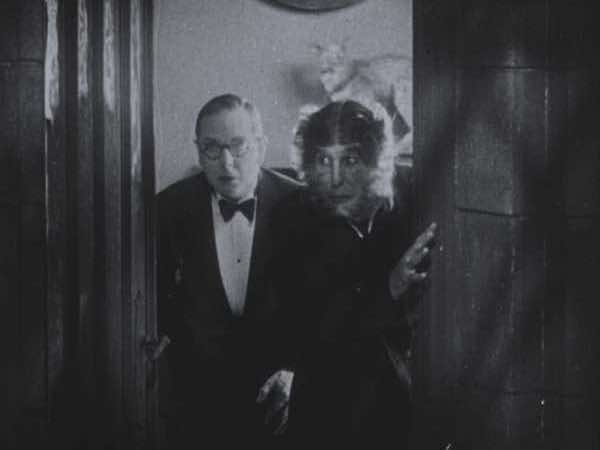SEVEN FOOTPRINTS TO SATAN
(La scala di Satana)
Benjamin Christensen (US 1929)
The naïve, sheltered Jim Kirkham has inherited a large fortune and announces his intention to slake his thirst for adventure by going to “darkest Africa” to seek a lost city. His uncle Joe and his girlfriend Eve try to dissuade him, but he remains determined. Attending a large party where Eve’s father shows off a priceless gemstone, Jim quizzes a mysterious guest whom he suspects might be an impostor; suddenly, several others pull out revolvers and start shooting, and pandemonium erupts. Jim flees with Eve, but they find themselves locked inside the car and taken to a vast mansion belonging to the mysterious Satan. Here, they come upon all manner of bizarre goings-on, including a huge, orgy-like party, but their attempts to escape are thwarted again and again by strange and unsettling figures. At the end, to save Eve, Jim is forced by the hooded figure of Satan to confront the challenge of the seven footsteps, risking servitude – or death.
A delightfully bonkers haunted house comedy-thriller in the mold of The Cat and the Canary (which also featured Creighton Hale), the film is marked throughout by Christensen’s delight in shadow effects and riotous sense of humor. It is based on a grim and serious, even sadistic terror novel written in 1927 by the top pulp writer Abraham Merritt (whose extravagant fantasy The Ship of Ishtar remains a great read). In Merritt’s novel, Satan is an imaginatively sinister and demonically cruel Fu Manchu-like master criminal, but in this adaptation by Christensen and William Irish he becomes a very different figure, in keeping with the light-hearted tone of the film. Merritt’s Kirkham is a hardened man of action, an ex-secret agent and Indiana Jones-like adventurer; the movie’s Jim is a bespectacled, wide-eyed dilettante.
Still, Christensen’s film features many elements of menace and perversity: Satan’s mansion is peopled by an extraordinary gallery of weird and threatening figures, including a turbaned oriental played by Sojin (the villainous sorcerer from Fairbanks’ The Thief of Bagdad), a slinky black-dressed femme fatale, and a killer ape. The place is filled with secret doors popping open to startling effect, and while the orgy scene stays well within the boundaries of what a Hollywood film could show at the time, the atmosphere still seems remarkably debauched. Christensen presents us with some really startling images – a ballroom filled with black-hooded men dancing with masked ladies in elegant gowns; a dainty hand with a jeweled bracelet reaching out of a coffin; and a naked woman held down by a gorilla’s paws to be whipped – or worse.
Historian Arne Lunde has argued that the film is “a modernist and self-reflective text”: “the nonsensical architectonic heterogeneity and abrupt spatial dislocations of the film’s three mystery mansions double for the American film factory itself. Creighton Hale’s Jim Kirkham is a Harold Lloyd/Buster Keaton-like naïf trying constantly to make sense of an unstable world of generic narrative fragments that keep shifting, evaporating, and transforming around him” (Journal of Scandinavian Cinema 1:1, 2011, p.16). In Christensen’s Hollywood publicity shots, he is practically never seen without a cigar – even when lying on the floor setting up a low-angle shot – and Lunde suggests that the cigar-smoking Uncle Joe can be seen as a stand-in for the director.
Christensen made his mark as a director with his first two Danish films, Det hemmelighedsfulde X/The Mysterious X (1914) and Hævnens Nat/Blind Justice (1916), followed by the extraordinary Swedish production Häxan/Witchcraft Through the Ages (1922). After two years in Germany, Christensen moved on to Hollywood in 1925, making several films for M-G-M before joining First National, where he made four smaller-budgeted but apparently quite successful films, of which Seven Footprints to Satan is the only one to survive. It followed two other mystery-comedies, The Haunted House and House of Horror. Seven Footsteps was also considered lost until the 1960s, when a nitrate print with Italian titles was discovered in the collection of the Cineteca Italiana in Milan.
Casper Tybjerg

scen: Richard Bee [Benjamin Christensen], dal romanzo di/from the novel by Abraham Merritt (pubblicato in 5 puntate/ serialized in 5 parts, 1927; pubblicato come romanzo/published as a novel, 1928).
didascalie/titles: William Irish [Cornell Woolrich].
photog: Sol Polito.
mont/ed: Frank Ware.
make-up: Perc Westmore.
cast: Thelma Todd (Eva/Eve Martin), Creighton Hale (James “Jim” Kirkham), Sheldon Lewis (Il ragno/The Spider), De Witt Jennings (zio/Uncle Joe), Sojin (maggiordomo di Satana/Satan’s majordomo), Laska Winter (amante di Satana/Satan’s mistress), Nora Cecil (l’ancella di Satana/Satan’s housemaid), William V. Mong (Professor X), Kalla Pasha (il falso/the false Professor Wrede), Angelo Rossitto (il nano/the dwarf), Doris Dawson (la preferita di Satana/Satan’s chosen one), Thelma McNeil (donna nella casa di Satana/woman in Satan’s house), Loretta Young (vittima in abito bianco/victim in white dress).
prod: Wid Gunning, First National Pictures.
uscita/rel: 17.02.1929?
copia/copy: DCP (dal nitrato della versione italiana, con colonna sonora First National-Vitaphone mancante/from a nitrate print of the Italian distribution version, missing the First National-Vitaphone soundtrack), 70′; did./titles: ITA.
fonte/source: Cineteca Italiana, Milano.


 Italiano
Italiano